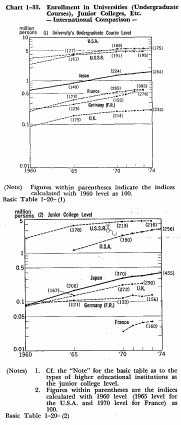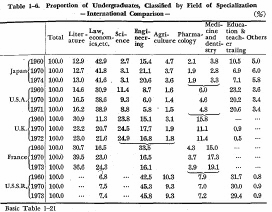| Home > Policy > White Paper, Notice, Announcement > White Paper > EDUCATIONAL STANDARDS IN JAPAN 1975 > CHAPTER1 4 (3) c | ||
Increase of Enrollment
The trend toward increasing enrollment in institutions of higher education is a phenomenon common to the countries considered here. Each country has been exerting strenuous efforts toward the enlargement and diversification of higher education in order to cope with the growth and diversification in the demand for higher education. The size of and increase in enrollment at the "undergraduate course level" and at the "junior college level" among those institutions of higher education in each country are shown in Chart 1-33.

As for the enrollment at the "undergraduate course level," the U.S.A. ranks the highest, followed by the U.S.S.R. and Japan. In terms of the growth index during 1960-70, France at 265 was the leader, while all other countries except the U.S.A. stood at 200 or so. With the l970s, however, the pace of increase has been slowed in each country except in the Federal Republic of Germany.
As for the enrollment at the "junior college level," the U.S.S.R. ranks the largest, followed by the U.S.A. and Japan. As for the proportion of enrollment at the "junior college level" in the combined enrollment at the "undergraduate course level" and "junior college level," the United Kingdom led with 54.l% in 1972, followed by the U.S.A. at 33.0%, the Federal Republic of Germany at l9.0%, Japan at l8.8% and France at 5.7%. As for the increase in enrollment at the "junior college level," attention should be called to the fact that it far surpasses the growth rate of enrollment at the "undergraduate course level" in five countries excluding the Federal Republic of Germany.
Proportion of Undergraduates, Classified by Field of Specialization
As is shown in Table 1-6, the proportion of total enrollment in universities (undergraduate courses) for each field of specialization, the proportion of enrollment in the field of liberal arts is generally high in Japan, the U.S.A. and France, exceeding 50% in recent years. In the U.S.S.R. on the other hand, the proportion of enrollment in the science field exceeds 50%. Further, in the U.S.A. and U.S.S.R., the proportion of enrollment in the field of education and teacher training is high.
As regards the transition in enrollment for each field of specialization, it is noteworthy that, while the proportion of enrollment in science and engineering fields is on decline in the U.S.A. and France, and that enrollment in the field of agriculture has been shrinking or levelling off in all of these countries.

Proportion of Female Students
While the proportion of female students among undergraduates has been growing yearly in every country, the U.S.S.R. ranks the highest in this regard, followed by France and the U.S.A. The proportion of female students in Japan has also been growing yearly, but still ranks he lowest among these countries. In Japan, however, the proportion of female students in the total enrollment in universities and junior colleges (regular courses) combined stood at 32.0% (as of 1974).

| Back to Top | MEXT HOME |